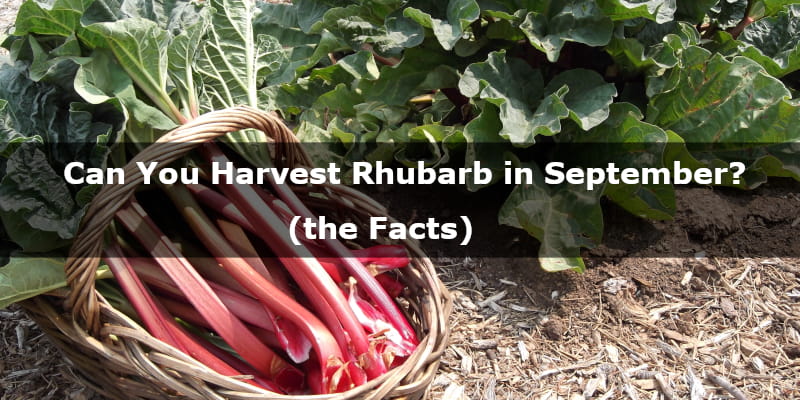Rhubarb cultivation and harvesting are both simple processes, manageable for home gardeners. Though, I do agree, that harvesting may be confusing to beginners.
I often hear from first-time growers, “Can I harvest rhubarb in September?” I would say yes, but there are nuances to this answer.
In this guide, I’ll address all your queries about harvesting rhubarb, the best time for it, and more. Let’s dive in.
Can You Harvest Rhubarb in September?
Technically, you can harvest Rhubarb in September. However, it may not be an ideal time to harvest the pie plant, because rhubarb in the fall needs to store energy for the next season.
Rhubarb, also known as the pie plant, is a unique plant and has delicious edible stems. People use and cook rhubarb for food, including chutneys, pies, and more.
The leaves of this plant have toxins, and only the stems are edible. It is typically grown in mild to cool regions. If properly taken care of, rhubarb can grow every year.
What’s the Best Time to Harvest Rhubarb?
Although the plant is ripe all spring and summer, the stems are edible and in their best form in the early spring-summer months. So, you can pick the stalks from April to mid-June for the best taste and texture.
Rhubarb grows during the spring and summer in the US and Canada. But you need to ensure that the plant is well-established so that you don’t weaken it by cutting it too much or too early. Hence, you will need to wait around 1-2 years before pulling stalks if rhubarb is freshly planted.
When the stalks are at least 8-15 inches (20-40 cm) long, you should know that is the best time to harvest. At this point, the plant has matured enough to endure being harvested.
Now that you know when you should grow this plant. Let’s learn a little about the process as well. Harvesting rhubarb is a pretty straightforward process.
Here is how it goes:
- Rhubarb stalks can be pulled by hand. However, if you find the process difficult, gently cut them at the base with a gardening shovel, shears, or a sharp knife.
- Never harvest all the stalks off this plant because it will adversely affect its growth. As a good rule of thumb, harvest one-third of the entire plant every season.
- After pulling the stalks, remove the leaves off them and throw them away. You don’t want to eat these leaves since they are poisonous and contain toxins. So, discard them using your fingers or kitchen scissors.
- Leaving this mess on the rhubarb plant can promote the spread of infections. Therefore, clean up the area and remove broken stalks, extra leaves, etc.
When is the Last Time You Should Harvest Rhubarb?
It is suggested that home gardeners stop harvesting rhubarb by mid-June. Fall and winter are the dormant seasons for rhubarb plants, and they need to store energy for these months to survive.
So, if you keep picking rhubarb even in July and August, its growth will be stunted. As a result, the quality and yield of the crop would decline next year, and it would become inedible.
Why is it not Recommended to Harvest Rhubarb in September?
You can harvest rhubarb in early fall in September. However, this plant needs energy to survive in winter, and overcutting can damage it.
After a successful summer harvest, the pie plant needs time to replenish, and harvesting in the winter deprives it of the necessary strength.
The plant may weaken, and your crop’s yield and quality can drop drastically. Therefore, harvesting should ideally halt or at least be reduced by late June to early July.
Things to Know About Harvesting Rhubarb
Here are a couple of things you should consider regarding harvesting the rhubarb plant:
- As I mentioned before, you should wait for at least one year before picking stalks from rhubarb. The plant needs to develop a solid root system, and harvesting before that will only weaken it.
- For starters, grab a ruler with you because you will need to take some measurements.
- Now, with the help of the ruler, check the length of the stalks. Ripe stalks are between 8-18 inches long.
- If they are smaller than 8-inches, know that it is certainly not the time to pick them. The stalks will be richer in taste the longer they are. (Length does not include leaves, only stalks)
- You will also have to measure the width of this plant. The width of rhubarb stalks should be between ½-1 inches. If they are thinner than that, leave them as they are.
- The color of rhubarb does not reflect how ripe it is. Many gardeners believe that when stalks turn a bright red hue, they are ready to be picked.
- But it is not always the case. In fact, some varieties have unusual shades of red and even green. Checking their length and width is the only way to know if they are ripe or not; don’t let the vibrant hues mislead you.
Conclusion
Growing and harvesting rhubarb is pretty simple for everyone. If you are first time growing the rhubarb plant, keep the harvesting tips shared in this guide in mind.
This plant is ripe all spring and summer. And although you can harvest it even in early fall, it is best to stop harvesting by late June. I hope this article was helpful. Thank you for reading.
References:
gardeningknowhow.com, britannica.com, dmcoffee.blog, wikihow.com, wisfarmer.com


